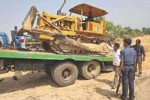
Like the Greek god Janus Bangladesh as a brand name to outsiders reveals two sides. But unlike the Greek god’s image the two sides in brand Bangladesh are not alike. Far from being a simulacrum of each other they are in stark contrast. Take the most recent example publicised in print an electronic media prominently and graphically. The department of environment seized 10 bulldozers of the Korean Export Processing Zone Authority (KEPZA) in Chittagong for allegedly illegal hill cutting. According to the department permission was given for ‘hill dressing’ and not for ‘hill cutting’; the difference between the two was left unexplained by the spokesman. The yellow earth freshly levelled from hills depicted in photos shows that even if the allegation is true the action taken by the department was very much like the proverbial case of closing the barn door after the horse had bolted. Even a cursory look at the site indicate that it took weeks and not days for the hills to be cut and levelled the way it has been done.
What was the department doing during this time? If they were as vigilant and active as their action purportedly claims, violation by the KEPZA would have been noticed within days allowing the department to prevent the damage. It is not only the hills that have been the alleged victims, the image of Bangladesh as an investment-friendly country has also received a blow. It has shown the lackadaisical manner in which investors, local and foreign, are treated by concerned government agencies most of the time. If someone imputes motives to such errant behaviour as seen in the KEPZA case one may not be wide off the mark.
The other side of brand Bangladesh is that in spite of the many aberrations from the ideal investment environment foreign investors are coming forward with money, technology and experience to invest in Bangladesh. Some of them are very patient, so patient that it beggars belief. KEPZA could not launch their operation in full swing even after 17 years and yet hung on inspired by hope. According to a newspaper report the government handed over land for the zone in 1999 but issued operational license only in 2007. The deed of transfer was not completed at the time as a result of which KEPZA could not lease out industrial plots to potential investors. It is a measure of the attraction of brand Bangladesh that the Korean investors behind KEPZA did not give up and continued with their weary plodding through the thickets of formalities and put up with the snail’s pace at which things moved in the official labyrinth. The tenacity to hold on to their attraction for investment in Bangladesh against odds is the bright side of brand Bangladesh. Behind it are, of course, various incentives given by the government of Bangladesh and opportunities available in the market, particularly availability of cheap labour. The pull of these incentive are being pushed out by the difficulties created by the absence of required infrastructures and the presence of a bureaucracy that is lukewarm about making it easy for foreign investors to work in Bangladesh.
As of now the balance of ‘pull’ and ‘push’ factors has worked to the advantage of Bangladesh. Foreign investment has not declined over the years giving cause for concern, but neither has it spiked continuously, not to speak of significantly. According to the World Competitive Index, a report prepared by the World Economic Forum, Bangladesh slipped one point in 2011 from the previous year and was placed at 177. It is small comfort that Bangladesh is above India in the global competitive index because the need for India to attract FDI is not as strong and urgent as is the case with Bangladesh. A report prepared by the Japan Bank for International Co-operation shows that Bangladesh though continues to be an attractive investment destination has slipped one step and is now placed at 16th position compared to 15th in 2010. The Japan External Trade Organisation has revealed in its report that Bangladesh is gradually losing its attractiveness to foreign investors because of relatively high and growing investment costs and a wide gap between existing government policies and their implementation. The World Bank’s Worldwide Governmental Indicators (WGI) has also come up with a similar report that shows very poor performance of Bangladesh in the areas of rule of law, government effectiveness and regulatory quality, all of which are among important determinants of a country’s investment climate. The World Bank Report has mentioned some of the problems that have faced investors for a long time. These are well-known and familiar to any investor, local or foreign, and are almost given. But the familiarity and inevitability do not attenuate their damaging impact on investment. Mentioning these one by one, the World Bank Report has observed that infrastructure services is very poor in Bangladesh which increases the cost of doing business in the country. The biggest concern, according to the Bank, is the electricity supply which is available to about 59.3 per cent of people. Frequent power failure compounds the problem, particularly for investors. According to the report of the Bank port services in Bangladesh are worse than in any other Asian country. The Report points out that much of the problem is centred in Chittagong port which is plagued by labour problems, poor management and lack of equipments.









